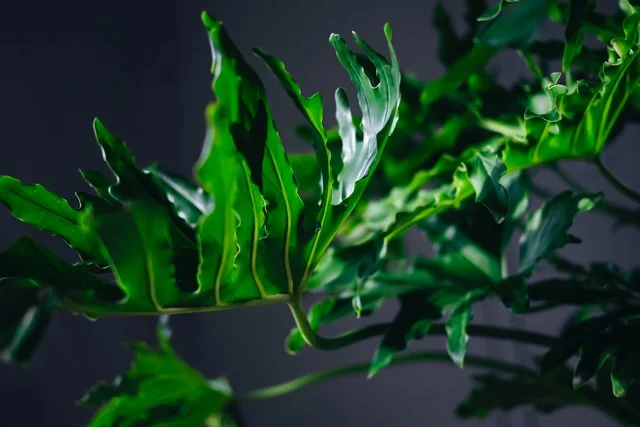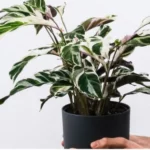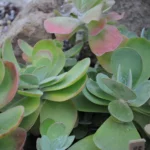Table of Contents
Caring for Philodendron Xanadu
Philodendron Xanadu, also known as Philodendron Winterbourn, is an interesting choice in philodendron.
It’s much more bush-like than most philodendron houseplants, and it grows out and up but isn’t a trailing vine plant. Instead, Philodendron Xanadu makes an appealing pillow-like mound.
Like most philodendrons, Philodendron Xanadu has vaguely heart-shaped leaves. These, however, are a bit more elongated than many, and the jagged shape of the Philodendron Xanadu’s leaves, similar to Tree Philodendron’s, also make the heart shape that philodendron plants are named for a little less obvious than it is on most philodendrons.
Philodendron Xanadu is a good choice for people who want a philodendron that doesn’t always immediately look like a philodendron.
Helping Philodendron Xanadu Thrive
Philodendron Xanadu is a little more hardy than the average philodendron. It does, like all plants, still have conditions under which it does best.
Even the more forgiving tropical plants still appreciate warmth and humidity, and Philodendron Xanadu is no exception. For it to reach its maximum size of four feet tall and 5 feet wide, it needs both of these, as well as proper lighting.
This will also give the Philodendron Xanadu leaves that are shiny and healthy.
Yellowing or browning leaves, wilting, and legginess are all signs that something isn’t quite right with the Philodendron Xanadu.
Light Requirements
Like many tropical plants, Philodendron Xanadu likes bright, indirect light. However, it does like it a little brighter than most philodendrons and can even tolerate some careful, direct sunlight, depending on your climate and how hot the sun is.
If Philodendron Xanadu doesn’t have quite enough light, instead of just slowing its growth or failing to thrive, this enterprising little plant tries to grow closer to the light.
This creates more stem in between leaves, giving the plant a leggy appearance. To keep the Xanadu looking tidy, adequate light is essential.
If Philodendron Xanadu receives too much direct light, the leaves can end up scorched.
Temperature Requirements
Philodendron Xanadu appreciates warm temperatures but is generally comfortable in average indoor temperatures. It likes temperatures a little over 70 degrees Fahrenheit but won’t be harmed by temperatures that are a little bit warmer or cooler.
In the 60 degree range, growth will slow, and in the 50s, Philodendron Xanadu is likely to end up with some damage, so be sure that if you live somewhere that reaches lower temperatures, the Xanadu is indoors, at least when it is cold.
People in cold climates should be sure to plant the Xanadu in a pot and keep it indoors.
Soil Requirements
Philodendron Xanadu needs a well-draining soil. It can do well with any light potting soil, or you can give it a mix of compost, perlite, and bark. The goal is to provide the Xanadu with soil that retains moisture but doesn’t keep water against the roots in a way that can lead to root rot.
If planting a row of Philodendron Xanadu outdoors, be sure to give the plants at least three feet so they can properly grow outward without crowding each other.
Humidity Requirements
As a tropical plant, Philodendron Xanadu appreciates a humid climate. If you live somewhere with average to high humidity, it should be fine.
If you live somewhere a little more on the dry end, you may want to provide the plant with some additional ambient humidity.
You can do this by setting out water, by providing the plant with a tray with pebbles and water underneath its pot (but not blocking drainage holes!), or by using a humidifier.
How to Water
Philodendron Xanadu likes to have moist soil, but it doesn’t do well with being wet. Before watering, check the top couple inches of soil. If this is dry, it’s safe to water the Philodendron Xanadu.. If it’s still damp, it’s best to wait a little longer.
Yellowing leaves are a sign of overwatering and mean the plant should go a little longer in between watering.
How to Fertilize
Apply a well-balanced fertilizer, diluted by half, monthly during the growing seasons of spring and summer. If you live in a warmer climate, you can probably fertilize it in fall as well.
If Philodendron Xanadu is growing very slowly despite adequate light and other favorable conditions, it may need more fertilizer or one specifically formulated for tropical plants.
If the leaves start showing signs of burning just at the edges, there may be too much mineral build up in the soil, and it should be fertilized less frequently or at a more diluted strength.
Extra tips for Philodendron Xanadu
Pests and Diseases
Philodendron Xanadu isn’t particularly prone to pests or diseases. Watch for root rot, which you can avoid with the proper drainage and lack of overwatering.
Philodendron Xanadu can also get common pests such as aphids, mealybugs, and spider mites.
Ridding Philodendron Xanadu of Pests
To rid a plant of pests, manually wipe down or remove any signs or infestation. You can use a damp cloth. Then, treat the plant with a gentle insecticide or apply neem oil, and check nearby plants to see whether they need to be treated as well.
Pruning
Philodendron Xanadu really only needs pruning of dead or damaged leaves. If size becomes an issue, propagation by division is a good way to lessen the burden on a single pot.
Propagation
The best way to propagate Philodendron Xanadu is by division. This also helps manage the size of the plant.
Carefully separate stems from each other at naturally occurring divisions, gently untangling the roots as you go. Plant both sections in moist soil and keep an eye on them as they recover from separation and repotting.
Some guides mention that propagation for sale of the Xanadu is prohibited, but propagation for personal use is always okay. If you’re planning to propagate the Xanadu in order to sell it, check your local regulations.
Toxicity
Philodendron Xanadu is toxic to animals and humans, especially small pets like cats and dogs, and should not be consumed.
Quick Reference
- Light: Bright and mostly indirect
- Temperature: 60 degrees Fahrenheit or higher
- Soil: Well-draining and loose
- Humidity: Average to high
- Water: Water when soil starts drying; keep moist, not wet
- Pruning: Removal of dead or damaged leaves



